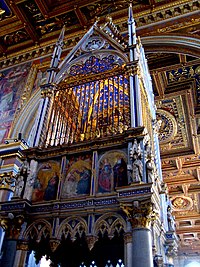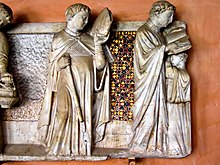Who Was Arnolfo Di Cambio in Art Matching Worksheet Answers
| Arnolfo di Cambio | |
|---|---|
 Arnolfo di Cambio by Vasari | |
| Born | Arnolfo di Lapo 1232/1240 Colle di Val d'Elsa |
| Died | (1302-03-08)8 March 1302/1310 Florence |
| Nationality | Italian |
| Occupation | Architect and sculptor |

The ciborium over the high chantry of St. John Lateran is derived from a pattern by Arnolfo di Cambio and decorated with paintings by Barna da Siena in 1367–1368. The muzzle to a higher place contains silver reliquaries which are said to concord the heads of SS. Peter and Paul.

Arnolfo di Cambio [1] (c. 1240 – 1300/1310[2]) was an Italian architect and sculptor. He designed Florence Cathedral and the sixth city wall around Florence (1284-1333),[3] while his most important surviving work every bit a sculptor is the tomb of Cardinal de Braye in S. Domenico, Orvieto.[4]
Biography [edit]
Arnolfo was born in Colle Val d'Elsa, Tuscany.

Detail of the tomb of Riccardo Fundamental Annibaldi, at St. John Lateran. This was the first major work of Arnolfo in Rome.
He was Nicola Pisano's chief assistant on the marble Siena Cathedral Pulpit for the Duomo in Siena Cathedral (1265–1268), just he soon began to work independently on an important tomb sculpture. In 1266–1267 he worked in Rome for Male monarch Charles I of Anjou, portraying him in the famous statue housed in the Campidoglio. Around 1282 he finished the monument to Cardinal Guillaume de Braye in the church of San Domenico in Orvieto, including an enthroned Madonna (a Maestà) for which he took every bit a model an aboriginal Roman statue of the goddess Abundantia; the Madonna'southward tiara and jewels reproduce antique models.[v] In Rome Arnolfo had seen the Cosmatesque art, and its influence tin can be seen in the intarsia and polychrome glass decorations in the Basilica of Saint Paul Exterior the Walls and the church Santa Cecilia in Trastevere, where he worked in 1285 and 1293 respectively. In this catamenia he besides worked on the presepio of Santa Maria Maggiore, on Santa Maria in Aracoeli, on the monument of Pope Boniface Eight (1300) and on the bronze statue of St. Peter in St. Peter'south Basilica.
In 1294–1295 he worked in Florence, mainly as an architect. According to his biographer Giorgio Vasari, he was in accuse of construction of the cathedral of the city, for which he provided the statues one time decorating the lower part of the façade destroyed in 1589. The surviving statues are now in the Museum of the Cathedral. While the blueprint of the Church of Santa Croce has been attributed to Arnolfo, this is highly disputed. Vasari also attributed to him the urban plan of the new metropolis of San Giovanni Valdarno.
The monumental character of Arnolfo's work has left its mark on the advent of Florence. His funerary monuments became the model for Gothic funerary fine art.
Giorgio Vasari included a biography of Arnolfo in his Lives of the Most Excellent Painters, Sculptors, and Architects.
Selected works [edit]
Compages [edit]
- Santa Maria del Fiore, Florence Cathedral, 1296. Arnolfo'due south design was extended and completed by other architects in the 14th and 15th centuries.[6]
- Palazzo Vecchio in Florence, 1299.[seven]

Tomb of Honorius 4 (The columns and upper entablature are of a later date).
Sculpture [edit]
- St. Peter Enthroned inside St. Peter's Basilica, is often attributed to Arnolfo.[8]
- Monument to Pope Adrian V (1276, attributed) – San Francesco, Viterbo
- Monument to Riccardo Primal Annibaldi (1276) – San Giovanni in Laterano, Rome[9]
- Statue of Charles I of Anjou (1277) – Campidoglio, Rome[x]
- Fountain of the Thirsty People (Fontana Minore) – Perugia[11]
- Tomb of Cardinal Guillaume de Braye (c. 1282) – San Domenico, Orvieto[12]
- Monument of Pope Boniface Viii – the Museo dell'Opera del Duomo – Florence
Footnotes [edit]
- ^ The name "Arnolfo di Lapo" by which he is mentioned in some sources was an invention by his biographer Giorgio Vasari. See Tomasi, 2007.
- ^ The traditional appointment of 1302 has been recently discovered to be incorrect. Run across Tomasi, 2007.
- ^ "Firenze-Oltrarno.net: City Walls".
- ^ Oxford illustrated encyclopedia. Judge, Harry George., Toyne, Anthony. Oxford [England]: Oxford University Press. 1985–1993. p. 22. ISBN0-19-869129-vii. OCLC 11814265.
{{cite book}}: CS1 maint: others (link) - ^ Roberto Weiss, The Renaissance Discovery of Classical Artifact (Oxford: Blackwell) 1973:fourteen note 2.
- ^ Heck, Johann Georg (1856). The Art of Building in Ancient and Modern Times, Or, Compages Illustrated. Vol. 1. D. Appleton. p. 182.
- ^ Norman, Diana (1995). Siena, Florence, and Padua: Case studies. Yale University Printing. p. 43. ISBN9780300061260.
- ^ Thomson de Grummond, Nancy (xi May 2015). Encyclopedia of the History of Classical Archaeology. Routledge. p. 84. ISBN9781134268542.
- ^ Gardner, Julian (March 1972). "The Tomb of Cardinal Annibaldi past Arnolfo di Cambio". The Burlington Magazine. Burlington Mag Publications Ltd. 114 (828): 136–141. JSTOR 876902.
- ^ Abulafia, David (2000). "Charles of Anjou reassessed". Journal of Medieval History. Tandfonline. 26 (1): 93–114. doi:10.1016/S0304-4181(99)00012-3. S2CID 159990935.
- ^ Gilbert, Creighton (1972). History of Renaissance Art: Painting, Sculpture, Compages Throughout Europe . H.N. Abrams. p. 24. ISBN9780810901698.
- ^ Krén, Emil; Marx, Daniel. "Tomb of Cardinal de Braye". Spider web Gallery of Art . Retrieved 26 September 2018.
Sources [edit]
- Tomasi, Michele (February 2007). "Lo stil novo del Gotico italiano". Medioevo (121): 32–46.
External links [edit]
- Arnolfo di Cambio in the "History of Art"
Source: https://en.wikipedia.org/wiki/Arnolfo_di_Cambio
0 Response to "Who Was Arnolfo Di Cambio in Art Matching Worksheet Answers"
Postar um comentário